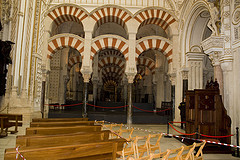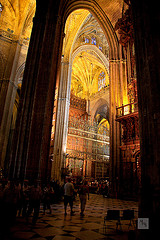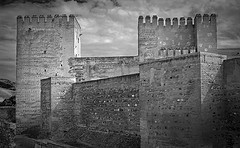Andalucia Attractions
Partly due to the mild winters and 300 average days of sunshine every year, Andalucia, and in particular, the Costa del Sol are attractive to visitors from Spain and northern Europe. There is no doubt that Andalucia has evolved into one of the hottest holiday destinations in the world. Whether you want to hang out with the rich and famous in Marbella and Puerto Banus, windsurf in Tarifa or soak up the sun in Sevilla, experience the appeal of this fabulous part of Spain.
 Jaén, Cordoba, and the rural inland mountain villages and towns still remain relatively untouched by tourism whereas the coastal areas welcome thousands of visitors every year, especially during the summer months. Andalucia is second only to Catalonia in tourism and sees over 30 million visitors each year.
Jaén, Cordoba, and the rural inland mountain villages and towns still remain relatively untouched by tourism whereas the coastal areas welcome thousands of visitors every year, especially during the summer months. Andalucia is second only to Catalonia in tourism and sees over 30 million visitors each year.
Andalucia tourist attractions
The main tourist area in Andalucia is the Costa del Sol and secondly, the Sierra Nevada. Almost 75% of nights booked in Andalucian hotels are in the coastal towns, where huge numbers of tourists flock to enjoy the sun and sand. Almost 15% of nights booked throughout the year are booked in August, and just over 5% in November/December.
On the west Atlantic coast are the Costa de la Luz (provinces of Huelva and Cádiz) and on the east, the Mediterranean coast, The Costa del Sol (including the provinces of Malaga and Cadiz). Coastlines in Andalucia also include the Costa Tropical (Granada and Almeria) and the Costa de Almeria. Over 60 beaches in Andalucia have been awarded the coveted Blue Flag Award for being in a good state of conservation, with sustainability, accessibility, and quality in mind.
Nature tourism has also increased in the more inland rural areas of Andalucia, plus cultural tourism in the larger cities, including Cordoba, Seville, and Granada. Sports tourism has also increased, including a massive increase in the number of tourists visiting the Sierra Nevada, Granada for winter sports.
Cultural tourists come to marvel at the many historical monuments dotted around Andalucia´s cities, many dating back to the days of Muslim rule in the region. These include The Great Mosque of Cordoba, the Alhambra in Granada, the Giralda and the Alcazar in Seville, plus the Alcazaba in Malaga.
Cathedrals, castles, forts, historic city buildings, and monasteries attract culture vultures from all over the world and the city centers of Jaén, Baeza and Úbeda are UNESCO World Heritage Sites.
If you are planning a family holiday or you simply want to relax in on the beach and soak up the sun, Andalucia offers miles of sandy beaches, forests, open countryside, and forests, plus some of the most amazing cities in the world. Andalucia covers 54,000 square miles and Nerja is the place where the Mediterranean meets the Atlantic, in dramatic fashion.
Provinces of Andalucia
Eight provinces makeup Andalucia and include Cadiz, Malaga, Cordoba, Jaén, Almeria, Seville, Huelva, and Cordoba. The population of Andalucia is almost 10 million, and most of those people live in the provincial capitals and in towns and villages along the coastline.
Tourists are spoilt for choice when it comes to places to stay, and they can choose from a range of package holidays, self-catering apartments, deluxe hotels, basic hostels, and guest houses. Andalucia is now easily accessible with the introduction of budget airlines, and most major cities, including Seville, Malaga, Jerez, and Cordoba can be reached directly from main cities in Europe. From the UK, Ryanair, Flybe, Monarch, Jet 2, and Easyjet fly several times a day to Malaga.
A wide choice of activities to suit all ages include water parks, amusement parks, beaches, pubs, clubs, biking, water sports, horse riding, and a vast choice of nightlife.
Malaga
Malaga is very much a seaside city with plenty of culture thrown into the mix. It is home to the famous Picasso Museum and claims to be the capital of the Costa del Sol (although Seville has the official title). Mild temperatures throughout the year and some fabulous attractions and beaches put Malaga at the top of the pile when it comes to tourist cities in Spain. Some amazing shops and designer boutiques also attract visitors from all over Andalucia, not to mention the fabulous restaurants, bars, and cafés.
Almeria
Almeria is the eastern capital of Andalucia and offers visitors plenty of traditional charm and history. Situated at the foot of a mountain range, Almeria´s jewel in the crown is undoubtedly the Alcazaba which was built by the Caliph of Cordoba. The Cathedral is magnificent and demonstrates Gothic and Renaissance architecture. Almeria is also the driest region in Europe and the warmest. If you are planning a visit, go and see the incredible Cabo de Gata-Nijar Natural Park with its volcanic origins. Many spaghetti westerns were also filmed here, thanks to its arid landscapes, including Clint Eastwood´s films, a fistful of dollars and The Good, the Bad and the Ugly.
Alhambra Palace
Granada is situated in the hills of the Sierra Nevada Mountain Range and the Alhambra Palace is one of the major tourist attractions in the region. Described as the ´Jewel of Moorish Spain´, the Alhambra was built when Spain was under Muslim rule in the mid 14th century by the Berber rulers of the Emirate of Granada, occupying the top of the hill of the Assabica on the south-eastern border of the city of Granada. From Granada, the ski destinations of Sierra Nevada are within 30 minute´s drive.
Seville
Seville, the official capital of Andalucia, is undoubtedly one of the most beautiful cities in southern Spain. Legend has it that the city was founded by Hercules and it is home to one of the world´s largest cathedrals and the Giralda Tower. The gardens at Santa Cruz and the Alcazar Palace reflect its Moorish culture. If you visit Seville make sure you visit the tapas bars, which are legendary. Delicious tapas for a fraction of the price you will pay on the coast.
Granada
There is so much to do in Andalucia, that you may have to book more than one trip to really get to know the region. If you are planning a visit for the first time, why not base yourself in Granada, enjoy the culture and the history of the great city and enjoy a few days on the Costa del Sol (just a 90 minute drive away). If you visit in winter, you can also enjoy the beautiful Sierra Nevada, and whether you are a skier or not, you can make the most of the sensational scenery.
Next trip, make sure you stay in Seville and enjoy the sights and sounds of one of southern Spain´s most exciting cities.
History of Andalucia
Andalucia´s rich history is almost as colorful as its people, and from humble beginnings, this region has evolved into one of Spain´s most flourishing provinces. Known as one of the most intriguing and historical parts of Spain, Andalucia owes a lot to its past rulers, who inhabited this region from 8,000 BC.

Neanderthal man was known to have lived on the Rock of Gibraltar 50,000 years ago, and around this time many North African tribes set up farming settlements nearby and became known as the Iberians. A chain of trading posts was formed by the Phoenicians around the Port of Cadiz in 1100 BC, making this one of Europe´s oldest cities. The Celts were the next tribe to reside across Southern Europe and Andalucia in 800 BC.
By 700 BC the Tartessus Kingdom was growing rapidly in the province, followed by the Greeks who founded trading ports along the shore. By the year 500 BC, the Carthaginians had colonized Southern Spain.
It wasn´t until 206 BC, along with the invasion by the Romans, that Andalucia began its transformation into one of the richest and flourishing colonies, with new roads and better organization. The Romans sailed up the River Guadalquivir as far as Cordoba, where they loaded olive oil and wine to send to Rome. Spain became a Christian country whilst under Roman rule in the 4th Century, and the Spanish language, originally derived from Latin, began to take its current form.
When the Roman Empire collapsed, Andalucia was invaded by wave after wave of barbarian tribes from Northern Europe, until the Visigoths took over. Rule under the Visigoths was disorganized and chaotic but they ran the region for two centuries until the invasion of the Moors from Arabia and North Africa in the year 711. The region then became known as Al-Andalus.
Andalucia has been indelibly marked by the Moor´s rule which lasted 8 centuries, and much of today´s culture and architecture still bears witness to the legacy of Arab rule – The Alhambra Palace in Granada and the Mosque of Cordoba are two of the more famous.
The Christian reconquest took place in the 15th Century when Cordoba and Seville were seized from the Arabs, and by the end of the Century, the Catholic monarchs, Isabel of Castille and Ferdinand of Aragon reclaimed the last stronghold of the Moors – The Alhambra Palace.
During the 16th and 17th Centuries, under Christian rule, Seville became the main port for imports of gold from the New World, as the Guadalquivir was blocked by silt, and Cordoba could no longer be reached from the river. Seville´s world-famous Torre de Oro (Golden Tower), still stands today (although it is no longer covered in gold), and attracts tourists from far and wide.
Much of Spain´s new wealth, which came from the import of gold, was used to finance the wars waged by the country´s Hapsburg Monarchy against the Lutheran countries in Northern Europe and against the Ottoman Turks in the Mediterranean. As the revenue from the Americas decreased, Spain and Andalucia sunk into economic decline.
 The country then suffered the Spanish War of Succession in the early 18th Century, and a hundred years later, the Napoleonic invasion, followed by the Battle of Trafalgar, which started the War of Independence. For the rest of the 19th Century, Spain was hit hard by the effect of the Independence Movement in South America.
The country then suffered the Spanish War of Succession in the early 18th Century, and a hundred years later, the Napoleonic invasion, followed by the Battle of Trafalgar, which started the War of Independence. For the rest of the 19th Century, Spain was hit hard by the effect of the Independence Movement in South America.
The loss of Spain´s last colonies – Cuba and the Philippines quickly followed, which led to political instability and further economic decline. In 1913, Blas Infante, known as the father of Andalucia, declared that the province should be given independence. At the same time, opposition to the then king, Alfonso XIII, was increasing – resulting in the outbreak of the Spanish Civil War.
The republic was overthrown in 1936 by General Franco and his Nationalist Movement. Although Spain did not side with any country during World War II, Franco openly lent his support to the Axis – which resulted in Spain suffering an international blockade after the war was over. Democracy was not restored to the country until Franco died in 1975, and the monarchy of King Juan Carlos II was then put in place. The Spanish government was then decentralized, and Andalucia became an autonomous region in 1982. The province has, till this day, its own regional administration known as the Junta de Andalucia.
Dramatic improvements have been made to the general standard of living in Andalucia and throughout the country since 1982, and Spain is now an active member of the European Union. Improved roads, better healthcare and an increase in tourism have seen a massive economic upturn in the region, while it still retains its original charm and beauty.
The rest, as they say, is history, and with the introduction of more budget flights to Europe, plus nearly 1 million UK expats in the region, there are is no shortage of things to see and do. Boasting some of the best restaurants, beaches, and cuisine in Spain, Marbella and Puerto Banus top the list of top holiday destinations in Andalucia. If you are looking for culture and history, visit the Mezquita in Cordoba or the incredible Catedral de Santa Maria de la Sede, in Sevilla. With over 320 average days of sunshine every year, you will have plenty of opportunities to explore Andalucia at your own pace.
